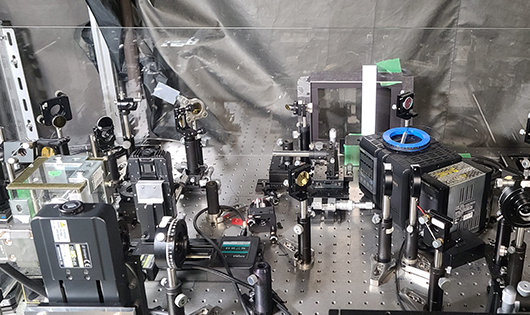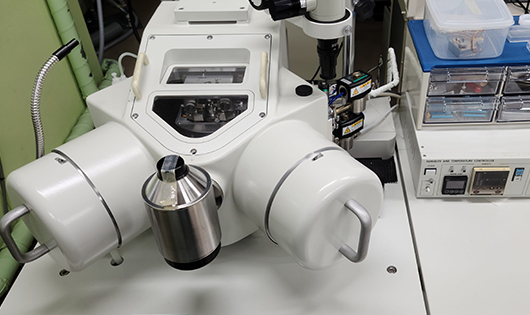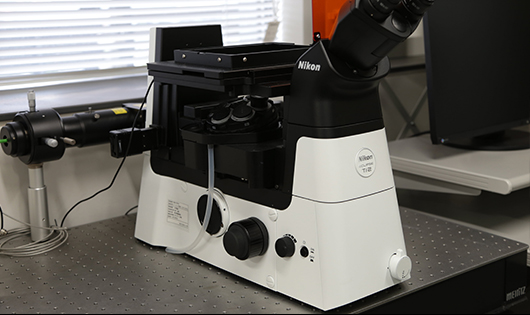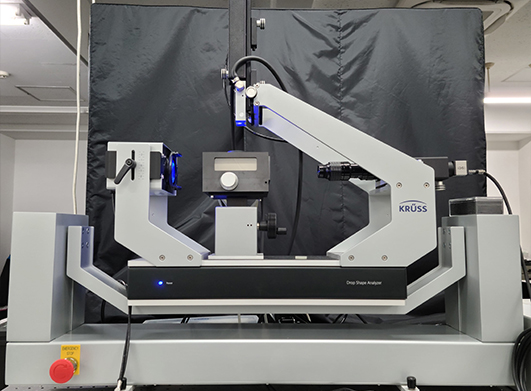"Water Interface" research
"Water" exists universally on the materials surfaces in various forms, changing its structure and supporting the functionality, and brings beneficial effects whereas it sometimes have unexpected adverse effects. At the "water interface," where water interacts with materials in complex ways, the physicochemical states of materials on the atomic and molecular scale and the nano- and micro-scale surface textures are closely related each other and governs the behavior of water, e.g., adsorption, wetting, and flow, in macroscopic perspective. This hierarchical interaction cannot be understood by a single disciplinary. Therefor, prediction and control of the complex behavior of the water interface is extremely importance. The Water Frontier Research Center (WaTUS) aims to promote leading-edge academic researches and create innovations that contribute to the society.
Our technologies

Heterodyne sum frequency generator
The aim of this research center is to elucidate the origin of the properties and functions that emerge at material surfaces and sliding interfaces where water is present, based on the structure of water on the nanometer scale. This system, a heterodyne-detected vibrational sum frequency generation spectroscopy (HD-VSFG) system, can selectively and sensitively detect water near the surface and obtain its vibrational spectrum. This allows detailed analysis of the surface structure. The spectral width of the output pulsed light is wide (> 400 cm-1), enabling multiplexed measurements over a wide spectral range at a time.
Model: Astrella-USP-1K/OPerA Solo System (COHERENT)
Location: Room 0501, 5th floor, Building No. 1, Kagurazaka Campus

Atmosphere-controlled scanning probe microscopy
Scanning probe microscopy is a powerful measurement tool for imaging the structure and morphology of material and material surfaces at the nanometer order. Furthermore, to comprehensively elucidate the role of water on the surface of materials, which is the central issue of this research center, it is essential to conduct measurements under the actual environment in which the material is used, i.e. maintaining the same temperature and humidity as the actual operating environment and maintaining the water adsorption layer on the material surface. Atmosphere-controlled scanning probe microscopy can measure atomic forces and frictional forces under controlled conditions of water adsorption on the material surface through temperature and humidity control, allowing multifaceted evaluation of the effect of water on material surface properties.
Model: SPM-9700HT/WET SPM (Shimadzu Corporation)
Facility Location: 12th floor, Building No. 1, Kagurazaka Campus

Interfacial fluorescence microscopy
Interfacial fluorescence microscopy enables fluorescence observation with a high signal-to-noise ratio in the vicinity of material surfaces at about 100 nm by using evanescent light, a localized non-propagating light, as the illumination light, instead of irradiating the entire sample with excitation light as in conventional fluorescence microscopy. This microscope enables flow measurement and single molecule observation in the vicinity of material surfaces to evaluate the interaction of fluids and molecules with the surfaces of materials. The system is equipped with lasers of 405 nm, 488 nm, 561 nm, and 640 nm wavelengths as excitation light sources, and can be used in combination with conventional epi-fluorescence microscopy, making it possible to compare and evaluate the behavior of bulk and near-surface materials.
Model: ECRIPSE Ti-2U/LAPP EPI + TIRF (Nikon)
Location: Motosuke Laboratory, 4th floor, Research Building, Katsushika Campus

Environment-controlled contact angle meter
Contact angle measurement is a technique to examine the angle between a liquid drop and a material surface, and is one of the representative methods to evaluate the macroscopic wettability of the material surface. This system can measure not only the normal contact angle (static contact angle), which is measured by keeping the material surface parallel to the ground, but also the tilt angle (fall angle) at which the drop begins to roll when the sample is gradually tilted, and the advancing and receding contact angles can be measured almost fully automatically. In addition, the temperature and humidity of the sample chamber can be controlled, enabling measurements that simulate actual operating environments and analysis of the effects of water adsorption from the atmosphere onto material surfaces on wettability.
Model: Drop Shape Analyzer (DSA) 25 (manufactured by KRUSS)
Location: Room 0501, 5th floor, Building No. 1, Kagurazaka Campus

